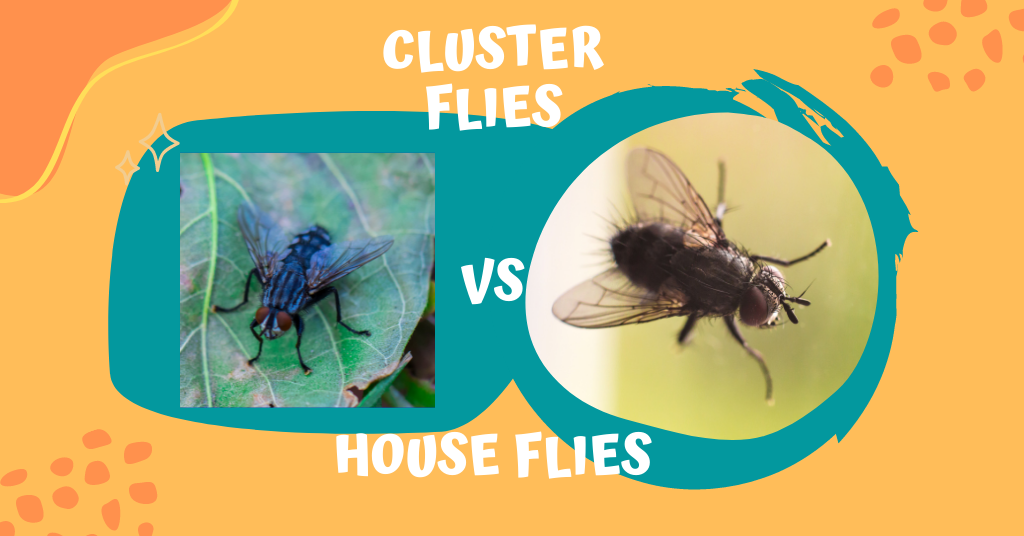
Jeffery Jago is a expert in horticulture and worm breeding. With a background in plant cultivation
Last Updated on October 1, 2021 by Jeffery Jago
The first step to dealing with a fly infestation is to figure out what kind of fly you have. The most common flies, and the difficult to tell apart, Are cluster flies vs house flies. These two fly species look very similar to each other to the untrained eye, and they both require different methods of pest control.
Luckily there are many differences between a cluster fly (Pollenia) and a house fly (Musca domestica) that with a bit of knowledge can help you identify the particular household pests you’re dealing with.

Cluster Flies Vs House Flies
Cluster Fly Characteristics
Cluster Flies are commonly known as attic flies, cluster flies, Early Winter flies, and scientifically known as pollenia Rudis. The Cluster fly is around 7mm long on average. The body colors will be a much darker black with almost checker patterns of silver along its back. This makes them slightly larger than common house flies.
They also have golden-colored hairs around their thorax. These golden hairs are easy to spot in the light.
Cluster flies are rather sluggish flies due to their overlapping wing structure. At rest, Their wings overlap making it harder for them to get moving. Compared to a house fly, they are quite slow.
As their name suggests, Cluster flies cluster together. The most common place for a cluster fly infestation will be in the attic. They’re attracted to sunshine and heat, so you will often find them bundles near windows, But not just windows.
They tend to get into everything. Behind tight spaces, inside every nook and cranny, wall voids, Electrical outlets, sealing cracks, other small openings, and hiding places. They can even be inside the insulation itself if there is an entryway. When you move into the attic, you won’t be swarmed by the flies, they will seem calm and almost ignoring you as they are so sluggish. They mostly prefer to live in unused areas of the house, Such as the attic or basement. Being attracted to light makes them easy to find near windows during cold but sunny winter days.
Cluster flies enter houses during the late summer and early fall months, which is why they are often called the winter fly. When the temperature gets low, these cluster flies look for a warm place to overwinter while hibernating so they can lay eggs in earthworm burrows in the early spring. This is one of the reasons for their sluggish movement.
Cluster flies enter the house through damage structures, damaged screens, Loose window screens, Cracks and crevices, Slightly bigger holes, and other un-protected areas. It should also be noted cluster flies do not and can not bite humans.
During the warmer weather months, and sunny days they do not need to survive indoors and prefer to live outdoors.
As such, Cluster flies do not lay eggs inside your home.. unless you happen to own a worm farm! They also do not carry any known diseases that can be transmitted to humans or animals, Overall, aside from their massive numbers, they are fairly clean household pests.
So aside from being annoying, Are cluster flies dangerous? Not really no.
So to recap, The 5 main Characteristics of a cluster fly is:
- Size and color: Black with checker pattern, 7mm average
- Flight patterns: Slow, semi-erratic, prefer not to fly around
- Behavior: Slow, Lethargic, Cluster
- Habitat: Summer outdoors, overwinter indoors in late summer and fall
- Danger level: Low, potential allergen

House Fly Characteristics
The common house fly, Also known as the house fly, filth flies, is scientifically known as Musca domestica. The average adult size of a housefly is 6mm long on average and will be lighter in color than the cluster fly.
The most common House flies are around 6-8mm (Near 1/4 inch) in length with dull grayish bodies, Similar to that of a wasp or bumblebee except for their distinct dark brown or narrow black stripes on their backs. Their wings also have similar patterns to help identify them.
Their wings do not overlap like the cluster flies wings do. So they appear to be far more energetic and quick.
House flies come into your home in order to scavenge for food as well as find a place to lay their eggs, which is inside rotting food, meat, or dead animals.
They will land on feces, rotting organic materials, and any other manner of waste. This causes them to carry many dangerous diseases and are to be considered dirty pest problems.
House flies do not live in a large population as the cluster flies live. But they do tend to gather from time to time to mate with other house flies.
So to recap, The 5 main Characteristics of a house fly are:
- Size and color: Dark grey with stripes, 6mm average
- Flight patterns: Erratic, Quick, Move at a frantic pace
- Behavior: Energetic and Annoying, Don’t cluster
- Habitat: Summer outdoors, overwinter indoors in late summer and fall
- Danger level: Moderate, potential allergen, Carries Dangerous Diseases. Dirty.

Preventing them from getting inside in the first place
Check out our page here for exterminating house flies and cluster flies if you’ve already got a problem!
So as you can see, there are many similarities between the 2 species, But the insects develop and go about in different ways that you can help tell the difference.
The first step to control cluster flies or the common housefly is to prevent them from getting into the house in the first place.
Many people make the mistake of waiting to see if they get a problem to treat them for either cluster flies or houseflies. But it is far better to take preventative measures before you actually need to use chemicals and expensive traps inside your home. (If you do, be sure to follow label directions. If you don’t follow label directions you could injure yourself or others in the house).
If you’ve got small children, pets, or someone in your family who has an allergic reaction to insects and flies, you’ll definitely want to keep them out before they become a problem.
Be sure to seal off any doors and windows that have cracks and crevices in between the trims. As well as sealing off any cracks and crevices in the attic roof.
Any large holes where cabled and pipes come in and out of your house should be sealed off as well. This not only keeps cluster flies out but also many species of nuisance pests.
For houseflies, Be sure to keep any screens repaired and free of holes. If you do not have screens on your windows make sure to add them.
Hanging flypaper and traps is also a good deterrent for cluster flies and common houseflies when used properly. These can be hung up in areas around your home with large entry points for the flies such as in tall garage doors, garages with large windows, and even alongside decks if they’re within walking distance from the entryways of your home.
Do remember that flies are drawn to rotting food and waste so be sure to clean up any spills or messes quickly either by cleaning or throwing away anything that could rot inside your home.
Be sure to vacuum regularly especially underneath furniture where it’s harder to get at such as under couches, beds, or chairs.
Caulking can be used to plug any small crevices or even large holes in the roof if you see gaps around vents, cables, or pipes that come into your home. This helps not only to prevent problems with flies but also rodents and other pests.
Always remember doors and windows are the biggest entry point and to have them closed at all times when not in use, Although some nuisance pests, and insects will always find a way in, especially in winter when the insects are desperate to get away from the cold.
And of course, When in doubt, or dealing with large numbers you can’t deal with on your own, Call in a professional exterminator who can gas all the flies in 10 minutes. This will also help identify other fly species, such as blow flies in your home that you might not have noticed.

